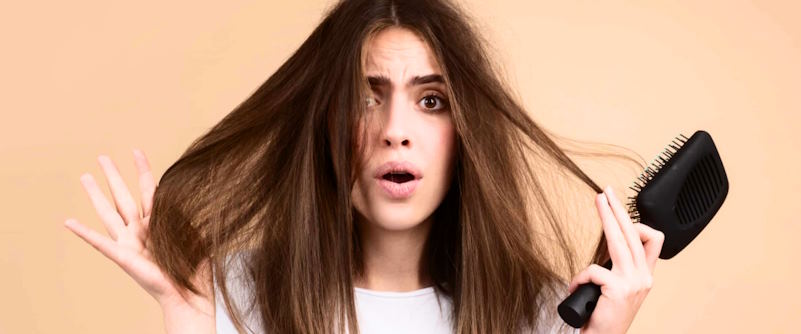
Managing Frizzy Hair: Reasons And Solutions
Here, we speak about a persistent challenge for many individuals, causing frustration and affecting confidence in their appearance. Dealing with frizz necessitates grasping the root causes, whether it be humidity, damage, or genetic predisposition, and applying suitable remedies accordingly.
Why do people come across frizzy hair?
Humidity stands as a leading factor behind frizz, as elevated moisture levels infiltrate the hair shaft, leading to expansion and frizz. Moreover, inadequate moisture levels contribute to frizz by roughening the cuticle layer, resulting in an uneven texture. Damage incurred from heat styling, chemical treatments, or environmental stressors can further compromise the hair’s integrity, intensifying frizz.
Besides, porosity levels further contribute. High-porosity hair absorbs moisture quickly but struggles to retain it, while low-porosity hair may resist moisture absorption, leading to dryness and frizz. Don’t forget about genetics. It can also influence hair texture and structure, predisposing some individuals to frizz.
How to deal with frizzy hair?
Hydrate
To restore moisture to the hair, pay attention to hydrating shampoos and conditioners containing ingredients such as glycerin, coconut oil, or shea butter. Additionally, indulge in deep conditioning treatments once or twice a week to give your hair an added boost of hydration, effectively combating frizz.

Use Anti-Frizz Products
Choose anti-frizz serums, oils, or creams enriched with components like argan oil, silicone, or keratin to smooth the hair cuticle and control frizz. Apply these products evenly throughout damp or dry hair, focusing on the mid-lengths and ends.
Gentle Styling
Adopt gentle styling methods to reduce friction and breakage, common culprits of frizz. Instead of harshly drying, gently blot excess moisture with a soft microfiber towel or an old T-shirt. When detangling, opt for a wide-tooth comb or a detangling brush to gently eliminate knots without risking damage.
Satin Pillowcase
Swap your cotton pillowcase for a satin or silk one to reduce friction and prevent frizz while you sleep. Satin pillowcases’ smooth surface minimizes friction between your hair and the pillow, helping to maintain your hairstyle and reduce frizz overnight.
Protective Hairstyles
Explore protective hairstyles such as braids, twists, or buns to safeguard your hair against environmental triggers like humidity, wind, and pollution, known to induce frizz. These styles serve to retain moisture and reduce exposure to external elements that may worsen frizz, providing a shield for your hair.

 Find your beauty inspiration with Lumination Salon. Our blog covers a wide range of topics from skincare to makeup, offering expert guidance to help you achieve your dream look.
Find your beauty inspiration with Lumination Salon. Our blog covers a wide range of topics from skincare to makeup, offering expert guidance to help you achieve your dream look.